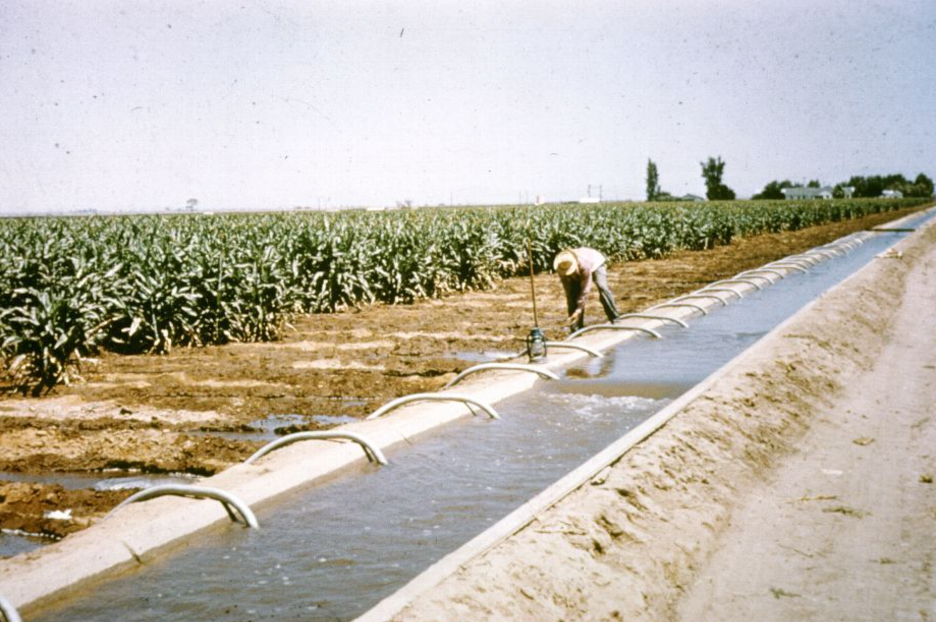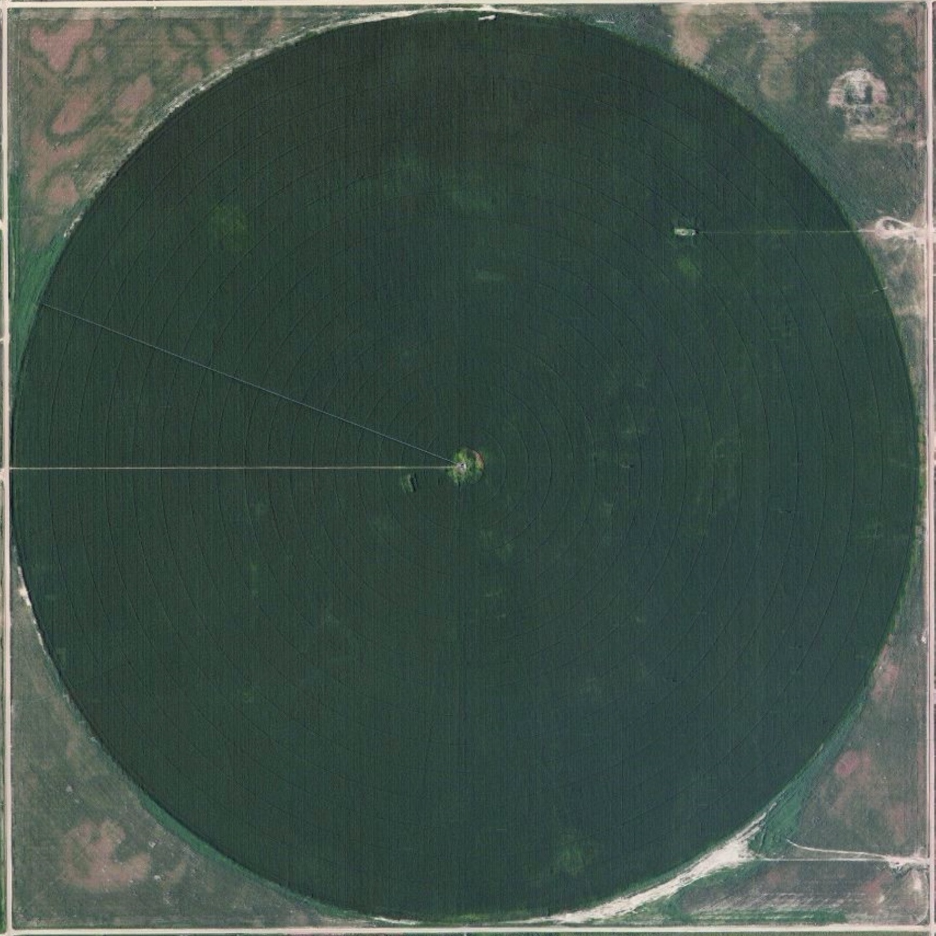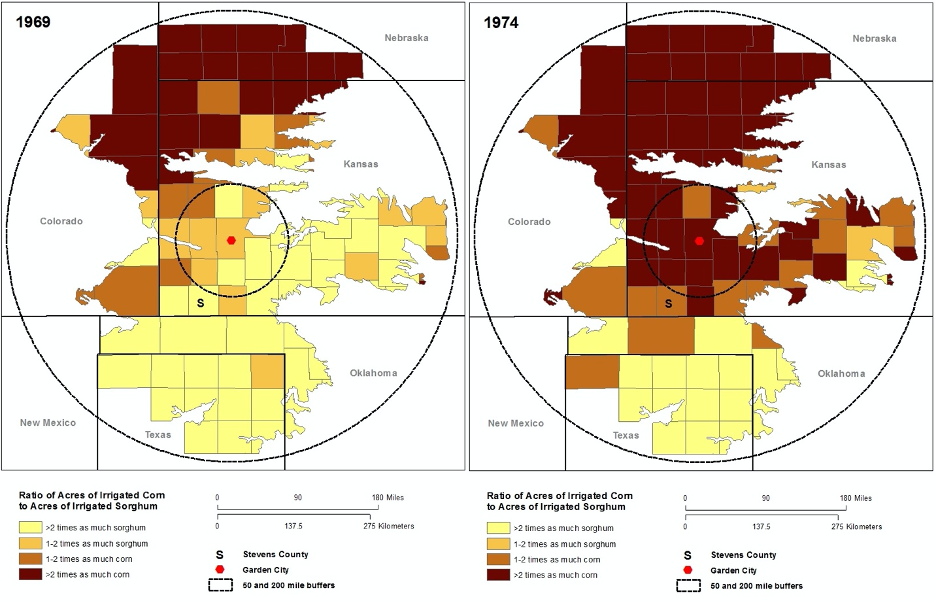Andrew Watson: "The Mirage of Industrial Agriculture"
The Mirage of Industrial Agriculture:
Fossil Fuels, Groundwater Irrigation, and Feedlots on the High Plains
Andrew Watson, University of Saskatchewan
Aerial view of the High Plains over southwestern Kansas (https://websoilsurvey.nrcs.usda.gov/app/)
This post is cross-listed with the Network in Canadian History and Environment (NICHE) and is based on the author’s recently published article in Agricultural History entitled “‘The Single Most Important Factor’: Fossil Fuel Energy, Groundwater, and Irrigation on the High Plains, 1955–1985,” vol. 94, no. 4 (Fall 2020): 629–663. The article will be freely available on JSTOR until November 16, 2020.
It should be cited as: Andrew Watson, "The Mirage of Industrial Agriculture: Fossil Fuels, Groundwater Irrigation, and Feedlots on the High Plains," The Short Rows, October 27, 2020. https://www.aghistorysociety.org/ahs-blog/watson-the-mirage-of-industrial-agriculture
The Ogallala Aquifer and the Hugoton-Guymon Natural Gas Field (map by author).
If you’ve ever flown over the Oklahoma and Texas Panhandles and western Kansas, chances are that you peered out the window and looked down on a landscape that looks something like the title image of this post. The quilt work pattern of lush green circular fields stretching off in every direction is mesmerizing, beautiful, and iconic. What you’re seeing are center-pivot irrigation fields. These landscapes are among the most technologically sophisticated agroecosystems on the planet. They are also incredibly unsustainable.
Since World War II, farmers on the High Plains have been using centrifugal pumps, internal combustion engines, and advanced irrigation systems, such as center-pivot, to break the ecological constraints of the region’s semi-arid environment by drawing millions of gallons of water from deep underground and distributing it to crops at the surface. The water upon which most High Plains farmers rely comes from North America’s largest aquifer, the Ogallala. Water in the Ogallala accumulated over thousands of years and replenishes much more slowly than the rate at which farmers have pumped it out. The energy they have used to lift and distribute the water is mainly natural gas from North America’s largest natural gas field, the Hugoton-Guymon, located thousands of feet below the Ogallala. Irrigators are therefore using one nonrenewable resource (fossil fuels) to exploit a second nonrenewable resource (fossil water).
Historians of agriculture have not spent enough time thinking about energy, which is often subsumed into discussions about scientific management, technological change, commodification, and modernization.[1] Similarly, historians of energy have overlooked agriculture in favor of resource extraction, urbanization, factory production, and transportation.[2] The history of center-pivot irrigation on the High Plains is an extreme example of something that is too often overlooked, which is that energy flows and agroecosystem land-use structure and influence one another.[3]
Windmill and small garden, Hamilton County, Kansas, 1935 (http://www.kansasmemory.org/item/229169).
Farmers knew there was water below the surface during the late nineteenth century, and during periods of drought they succeeded in lifting enough to the surface using windmills to irrigate a few acres until the rains returned. It was not until after World War II that the technology became available to allow farmers to lift enough water to support permanent and widespread irrigation. It was also after the war that gas companies dramatically increased the development of the Hugoton-Guyman gas field. Farmers with wells on their land, or a pipeline running across it, suddenly had access to abundant and cheap natural gas they could use to power the pumps and engines necessary to lift so much water.
“These landscapes are among the most technologically sophisticated agroecosystems on the planet. They are also incredibly unsustainable.”
Surface ditch irrigation, Kansas, ca.1950s (http://www.kansasmemory.org/item/211966).
Until the late 1960s, most irrigators pumped water to the surface and then delivered it to crops along ditches or through aluminum piping. Either way, surface distribution required significant human energy to dig the ditches and move the piping. Surface distribution also wasted a lot of water to evaporation, seepage, and run off. Over time, the water levels in Ogallala wells began to drop. Farmers became concerned about the declines, but they continued to draw water. When center-pivot irrigation systems became available during the late 1960s and early 1970s, many farmers embraced the technology because it saved them labor, and only secondarily because it applied water to the crops more efficiently.
Center-pivot systems saved human energy, but they required substantial fossil fuel energy to lift and distribute the water. Center-pivot systems swing a long arm, comprised of a series of connected pipes, around a wide circular path within the circumference of a large round field. Water enters the system in the center, is pumped out along the arm, and is sprayed evenly onto crops from a series of wheeled support struts. In 1978, lifting one acre-foot of water (the amount of water necessary to cover one acre to a depth of one foot) required 2 GJ. To distribute that water using surface methods used approximately 1 GJ, while distributing it using center-pivot used roughly 13 GJ.
Average depth to water in wells in each county overlying the Ogallala Aquifer (maps by author).
Center-pivot irrigation field, Stevens County, Kansas. USDA, Web Soil Survey. (http://websoilsurvey.nrcs.usda.gov/app/)
Using fossil fuels to lift groundwater enabled High Plains farmers to dramatically and consistently increase cropland productivity. One of the most important crops irrigators grew on the High Plains was sorghum. Sorghum had been a hardy crop that dryland farmers grew to feed cattle during the late nineteenth and early twentieth centuries, and they continued to grow it after irrigation technologies became available—but in much larger quantities. High Plains irrigated agriculture produced so much cattle feed during the 1960s and 1970s that it attracted the feedlot industry, which had up until that point been located mainly in the Corn Belt.
Between the 1960s and the 1980s, the proportion of fed cattle in the United States declined in the Corn Belt and expanded in the High Plains. By the late 1980s, approximately 40 percent of cattle in the United States were slaughtered within 250 miles of Garden City, Kansas. To accommodate the demands of the feedlot industry, which preferred corn to sorghum, farmers in the region switched from sorghum to corn during the late 1960s and early 1970s.[5] In Stevens County, Kansas, for example, farmers irrigated 11,867 acres of corn and 29,540 acres of sorghum in 1969. Nine years later, in 1978, they irrigated 24,528 acres of corn and only 1 acre of sorghum. Regardless of the crops they grew, farmers used fossil fuels to lift ancient groundwater to the surface to irrigate crops that were then fed to cattle, resulting in a low-energy return on investment.
“Almost from the inception of industrial irrigation on the High Plains right through to the present day, farmers have understood that the landscapes they created had an expiry date. Yet this knowledge had little effect on the scale and pace at which farmers exploited the Ogallala Aquifer.”
Proportion of Fed Cattle Marketed in US. Corn Belt states in red, High Plains states in blue (chart by author).[4]
Ratio of acres of irrigated corn to acres of irrigated sorghum within two hundred miles of Garden City, Kansas, 1969, 1974, 1978, and 1982 (maps by author).
Farmers understood very well how important groundwater was to their operations. But they took fossil fuel energy for granted—at least until the energy crises of the 1970s. Between 1970 and 1980, the price of natural gas increased by 800 percent. When natural gas became more expensive, so did groundwater. To save money, farmers switched back to growing irrigated sorghum, which required half as much water. In 1982, farmers in Stevens County irrigated just 15,670 acres of corn and 48,974 acres of sorghum. The feedlot industry called sorghum the “ace up its sleeve.”[6] As Kansas State University economist B. L. Flinchbaugh remarked, “Energy costs alone may be the single most important factor in determining water use.”[7] By the 1990s, fuel prices had stabilized and farmers began switching back to corn.
Almost from the inception of industrial irrigation on the High Plains right through to the present day, farmers have understood that the landscapes they created had an expiry date. Yet this knowledge had little effect on the scale and pace at which farmers exploited the Ogallala Aquifer. Fossil fuel energy made this possible, and will be abundant long after all the wells run dry. Farmers recognized that water represented the limiting factor in agriculture on the High Plains, but it was the availability of cheap fossil fuel energy that structured irrigation and land use. Climate change is forcing North America toward an energy transition away from fossil fuels. Currently, modern agriculture is heavily dependent on mineral energy, and irrigation requires relatively little energy compared to farm vehicles, pesticides, and especially fertilizers. Accomplishing a just transition must involve agriculture and imagine a future in which feeding people is not heavily reliant on fossil fuels.
[1] Deborah Fitzgerald, Every Farm a Factory: The Industrial Ideal in American Agriculture (New Haven: Yale University Press, 2003); J. L. Anderson, Industrializing the Corn Belt: Agriculture, Technology, and Environment, 1945–1972 (Dekalb: Northern Illinois Press, 2009); Katherine Jellison, Entitled to Power: Farm Women and Technology, 1913–1963 (Chapel Hill: University of North Carolina Press, 1993).
[2] Vaclav Smil, Energy and Civilization: A History (Cambridge, MA: MIT Press, 2017); Ruth Sandwell, ed., Powering Up Canada: A History of Power, Fuel, and Energy from 1600 (Montreal: McGill–Queen’s Press, 2016); Vaclav Smil, Paul Nachman, and Thomas V. Long II, Energy Analysis and Agriculture: An Application to U.S. Corn Production (Boulder, CO: Westview Press, 1983).
[3] An important exception is the work coming out the Sustainable Farm Systems Project. See the special issue on “Energy transitions in agroecosystems: Long-term changes in agroecosystem energy efficiencies on both sides of the Atlantic,” edited by Simone Gingrich, Geoff Cunfer, and Eduardo Aguilera, Regional Environmental Change 18, no. 4 (Apr. 2018): 1021–32.
[4] Kenneth R. Krause, Cattle Feeding, 1962–1989: Location and Feedlot Size (USDA, Commodity Economics Division, Economic Research Service, Agricultural Research Report No. 642, 1991), 5.
[5] Myron P. Gutmann, Great Plains Population and Environment Data: Agricultural Data, 1870–1997, Inter-University Consortium for Political and Social Research (June 2005).
[6] “Cattle industry seeks options,” Garden City Telegram, Mar. 21, 1985, 22.
[7] “Forced water policy expected,” Garden City Telegram, Feb. 11, 1983, 9.






![Proportion of Fed Cattle Marketed in US. Corn Belt states in red, High Plains states in blue (chart by author).[4]](https://images.squarespace-cdn.com/content/v1/5d3878547ea6120001bb0da8/1603215391679-LKSGDII59DBFEMZWMDOM/ProportionFedCattle)

